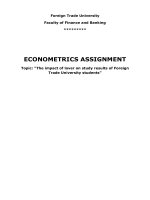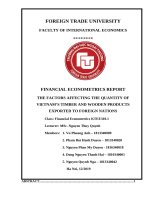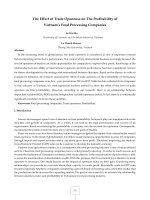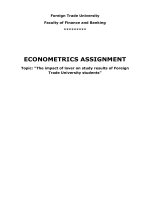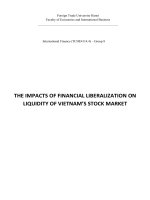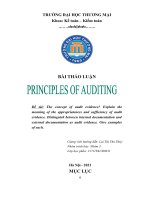Tiểu luận the impacts of financial liberalization on liquidity of vietnam s stock market
Bạn đang xem bản rút gọn của tài liệu. Xem và tải ngay bản đầy đủ của tài liệu tại đây (536.42 KB, 31 trang )
Foreign Trade University Hanoi
Faculty of Economics and International Business
_________________________________________________
International Finance (TCHE4114.4) – Group 8
THE IMPACTS OF FINANCIAL LIBERALIZATION ON
LIQUIDITY OF VIETNAM’S STOCK MARKET
LUAN VAN CHAT LUONG download : add
Final version, December 2012
Abstract
Vietnam has embarked on a course of economic reform, including stock market
liberalization on April 2007. This paper addresses the question of whether Vietnam’s
stock market has become more informationally efficient in the years following
liberalization. We find that Vietnam’s stock market does indeed become more efficient.
Additionally, using a panel data set and various measures of liquidity, we show that
liberalization leads to enhanced liquidity, after controlling for size and other relevant
factors. This confirms the intuition that stock market liberalizations render Vietnam’s
stock markets more liquid and efficient.
We would like to thank Ph.D Mai Thu Hien for invaluable comments and guidance
from the beginning of this research project.
2|Page
LUAN VAN CHAT LUONG download : add
Table of Contents
Members List..................................................................................................................... 2
Abstract.............................................................................................................................. 3
Table of Contents..............................................................................................................5
Introduction....................................................................................................................... 7
Part 1: Literature Review.................................................................................................9
1.1
Overview of the Impacts of Financial Liberalization on Stock Market...........9
1.1.1.
Definition of financial liberalization.............................................................9
1.1.2. Some commitment of Vietnam when joining the WTO about market
opening9
1.1.3.
Impacts of financial liberalization on stock market....................................10
1.2
Previous Studies on the Impacts of Financial Liberalization on Stock Market
11
1.3
Our Approach and Further Developments......................................................12
Part 2: Data and Methodology.......................................................................................15
2.1
Data Description.................................................................................................15
2.2
Empirical Methodology.....................................................................................15
Part 3: Empirical Results................................................................................................20
Part 4: Policy Implications of the Study Findings........................................................21
4.1
Vietnam's Stock Market Situation After Liberalization.................................21
4.1.1 The situation after financial liberalization date...............................................21
4.1.2
4.2
Government policies issued during the period.............................................25
Policy Implications.............................................................................................26
4.2.1
Restructure the stock market........................................................................26
4.2.2
Produce high quality products for the market.............................................26
4.2.3 Complete the legal documents and policies mechanisms for the
development of the Vietnam’s stock market..............................................................26
Conclusions...................................................................................................................... 27
3|Page
LUAN VAN CHAT LUONG download : add
References........................................................................................................................ 30
Introduction
In the process of globalization and international economic integration, financial
liberalization is an inevitable trend and brings many benefits to each country, especially in
developing countries. Thanks to financial liberalization, many developing countries have
attracted huge amount of capital investment and receive a modern technology platform
from industrialized countries to expand production and promote export. However,
increased capital inflows also make it difficult for the financial authorities in maintaining
the stability of local currency’s value and preventing a possible escape of investment
flows.
Vietnamese financial market has undergone a gradual process of liberalization
since the late 90s of the 20th century when the banking sector switched to 2-level model
and operated under the market mechanism. Financial market includes money market and
capital market, and the stock market is an important part of the capital market, and also, it
is considered to be a barometer of the economy. Therefore, since financial liberalization
has great impacts on the capital market in particular and the whole economy in general, it
must contribute significantly to the long-term development of stock market as well as it
fluctuations in the short-term.
The impact of financial liberalization on stock market can be evaluated based on
current theoretical models. Cost of stockholders’ equity consists of two components: the
equity premium (EP) - that is the difference in rate of return a company must pay to their
potential shareholders to buy its stock instead of investing in other risk-free financial
assets (such as short-term government bonds), and the risk-free rate (RFR) - that is,
interest paid on risk-free financial assets. The current theoretical models offer three
reasons why the financial liberalization may reduce the cost of equity. Firstly, the
financial liberalization may increase net capital inflows into the economy and thus reduce
the level of RFR (understood simply by increase in the supply of capital). Secondly,
allowing foreign investors to buy shares in a country will enable the sharing of risk
between resident and non-resident investors in that country, enhanced risk sharing will
reduce the EP. And finally, the increase of foreign capital into the economy will increase
the liquidity of the stock market, and thus, will reduce the EP (understood simply that
liquidity risk is reduced).
4|Page
LUAN VAN CHAT LUONG download : add
In addition, there are some papers using econometric method to research on this
issue in emerging or developing economies. In an article by E. Han Kim and Vijay Singal
(2000): Stock Market Openings: Experience of Emerging Economies, the authors found
that stock returns increase immediately after market opening without a concurrent increase
in volatility and stock markets become more efficient as determined by testing the random
walk hypothesis.
In another article, Konstantinos Kassimatis (2002): Financial
liberalization and stock market volatility in selected developing countries, the results
suggest that volatility fell after important financial liberalization policies were
implemented.
However, in Vietnam, there is no previous study using quantitative methods to
study the impact of financial liberalization on Vietnamese stock market, reviews and
assessments are just based on theoretical explanation as mentioned above or derived from
qualitative methods (as in the report “Securities market liberalization in Vietnam – Key
issues for the securities regulator and the domestic securities companies” by Multilateral
Trade Assistance Project EU-Vietnam MUTRAP III). Put another way, this issue is still
left open in Vietnam.
According to the SSC, the maturity of stock market is reflected vividly through
many numbers. Compared to 12 years ago, the market size is more than 50 times, the firstyear capitalization was of less than 1% of GDP, but by the end of 2011, it is nearly 27%.
Trading volume has increased 30 - 40 times higher than in the first-year transactions. The
number of listed companies was just more than 10 in the first year of market operation,
now it has risen to nearly 800 businesses. Mobilization capacity is indeed a noteworthy
point with nearly 700,000 billion VND mobilized into the economy over 12 years, peak
year is 2007 with 127,000 billion. Foreign portfolio investment inflows peaked up to $ 12
billion, now it is $ 6.7 billion, contributing to the balance of payments, as well as
increasing the attractiveness of the investment environment in Vietnam in the eyes of
international investors. Along with this rapid development, the stock market has become
an important channel to raise capital for the economy, instead of dependence on the
banking channel like before. Using econometric models, we hope to further clarify the
impact of financial liberalization on strong development of Vietnamese stock market in
the past 12 years, whether it plays a significant role in this outstanding development or
not.
Under the WTO’s commitments, Vietnam is gradually opening the market in most
sectors, especially financial market. In the near future, this international economic
integration will lead to significant changes in Vietnamese economy in general and the
stock market in particular. Thus, a thorough study about the effects of financial
liberalization on stock market is very important in order to help Government and financial
authorities in formulating policies to take advantage of as well as to deal with challenges
5|Page
LUAN VAN CHAT LUONG download : add
from financial market opening, bringing stable and sustainable growth for the stock
market in the coming years.
6|Page
LUAN VAN CHAT LUONG download : add
Part 1: Literature Review
1.1 Overview of the Impacts of Financial Liberalization on Stock Market
1.1.1. Definition of financial liberalization
There are a lot of definitions relating to the concept of financial liberalization. In
the simplest way, financial liberalization is the process of the elimination of
restrictions on financial markets and financial institutions. The term financial
liberalization is used to cover a whole set of measures, such as the autonomy of the
Central Bank from the government; the complete freedom of finance to move into
and out of the economy, which implies the full convertibility of the currency; the
abandonment of all "priority sector" lending targets; an end to government-imposed
differential interest rate schemes; a freeing of interest rates; the complete freedom of
banks to pursue profits unhindered by government directives; the removal of
restrictions on the ownership of banks, which means de-nationalization, full freedom
for foreign ownership, and an end to "voting caps"; and so on.
1.1.2. Some commitment of Vietnam when joining the WTO about market
opening
Principle ''market opening'', said in another way “market access”, in essence, is
opening the markets for foreign goods, services and investments. In a multilateral
trading system, the acceptance of opening the market of all the parties means a
creation of a global open trading system.
In political field, ''market access'' shows the principle of trading liberalization of
WTO. In legal filed, “market access” performs the obligations with binding of the
commitments of market opening which this country has approved when joining the
WTO.
Vietnam, when joining WTO, has made commitments about openings markets,
such as, tax, audit, accounting, insurance, transport and stock markets. In the scope
of this report, we focus on the commitments of Vietnam of stock market when
joining WTO.
Relating to securities services, Vietnam allows foreign investors to provide the
following services:
Transactions for your account or the account of customers at Stock
Exchange, OTC or others with the following services:
7|Page
LUAN VAN CHAT LUONG download : add
o The derivatives, also including future and option contracts.
o Transferable securities.
o Other transferable tools and financial assets, except solid gold.
(These services comprises of brokerage)
Involve in the issuance of any securities, including Underwriting, Agency
(offer to public or private) or providing relating services to that issue time
Asset management (portfolio management, all forms of collective
investment management, pension fund management, depository and trust
services)
The payment services and securities clearing, the derivatives and other
products relating to the securities
Provision and transfer of financial information, related software from
provider of securities services
Vietnam allows foreign companies and investors to do securities activities in
Vietnam at the following forms and conditions:
Representative office (provided that the agency do not do directly
profitable business activities)
Joint ventures with Vietnamese partners (provided that the proportion of
foreign capital contribution not exceeding 49%)
Stock enterprise with 100% foreign capital (from 1/11/2012)
Branches of foreign securities companies (since 11/1/2012 and conditional
branch operations limited to provide asset management services, payment
and securities clearing, provision and transfer of financial information,
related software)
1.1.3. Impacts of financial liberalization on stock market
Here in this part, we just make some predicts about the impacts of Financial
liberations on stock market according logical thinking.
Firstly, financial market and innovations are beneficial to the stock market in the
long-run because they lead to more efficient financial markets promoting lending
and growth. Liberalization has also enhanced the role of the equity markets in
several countries or, created them where they previously did not exist. Some
evidence in some following research also supports the financial liberalization thesis
that stock market volatility should fall following liberalization.
8|Page
LUAN VAN CHAT LUONG download : add
However, as restrictions are removed and financial liberations and innovations
are mismanaged, the freedom can encourage financial institutions to take
unnecessary risks going on lending sprees (Credit Booms) which can lead to
financial meltdowns.
1.2 Previous Studies on the Impacts of Financial Liberalization on Stock
Market
It is well known that the distribution of returns in emerging markets have special
characteristics: higher expected returns (Stulz 1999a, Henry 2000b, Bekaert and
Harvey 2000), higher volatility (Bekaert and Harvey 1997 and de Santis and
Imrohoroglu 1997), low correlation with developed market returns (Harvey 1995)
and a higher degree of predictability as compared to developed financial markets.
Harvey (1995) and Claessens et al (1995) show that emerging market returns are
more predictable than returns from mature markets.
Many recent papers have explored the impact of stock market liberalization on
equity prices and the macro economy in general. Henry (2000b) shows that a
country’s aggregate equity price index experiences abnormal returns during the 8month window leading up to the implementation of the stock market
implementation. He controls for macro-economic reforms, privatization and trade
liberalization and uses the event study approach. These results suggest a revaluation
of equity prices in anticipation of liberalization. Related work by Bekaert and
Harvey (2000) shows that liberalization tends to decrease aggregate dividend yields
and argue that the price change reflects change in the cost of capital rather than
change in earnings of the firm. Levine and Zervos (1998) show that increased
capital inflows may also increase stock market liquidity.
A series of paper document the impact of stock market liberalization on
physical investment and economic growth. Henry (2000a) shows that stock market
liberalizations cause investment booms in the years immediately following the
liberalization, after controlling for world business cycle effects, economic reforms
and domestic fundamentals. This paper argues that a fall in a country’s cost of
equity capital will transform some projects will negative NPV (before
liberalization) to positive NPV (after liberalization). Bekaert, Harvey and
Lundblad (2001) show that equity market liberalizations lead to a one percent
increase in annual real economic growth over a five- year period, even after
controlling for a number of standard determinants of economic growth. Fuchs9|Page
LUAN VAN CHAT LUONG download : add
Schundeln and Funke (2001) shows that growth tends to be higher when the stock
market liberalization is accompanied by institutional reforms. Das and Mohapatra
(2000) show that the gains from increased growth are unequally distributed,
accruing mostly to the top quintile of the population.
Two recent papers have directly addressed the issue the impact of stock market
liberalization on stock market efficiency. Kim and Singhal (2000) find that stock
markets become more efficient in the aftermath of stock market liberalizations.
Their analysis is based on calculating variance ratios. In addition to variance ratios
this paper uses nonparametric tests. Moreover, the cause of this increase in
efficiency is left unexplored in Kim and Singhal (2000), a question that this paper
addresses. Kawakatsu and Morey (1999) argue that liberalization does not seem to
have improved the efficiency of these markets. This result is contrary to our
findings. Furthermore, they do not explore the causes of change in efficiency.
1.3 Our Approach and Further Developments
The concept of market efficiency is a central one in finance. Fama (1991)
defines an efficient market as one in which asset prices ‘fully reflect all available
information’. The translation of the theory into empirical tests is problematic as
any test of market efficiency is a joint test of market efficiency and a particular
asset price model. Consequently, if the joint hypothesis is rejected, it is impossible
to determine whether the market is strictly inefficient or the asset pricing model is
ill specified. This argument will not be a concern, as this paper will focus on the
relative efficiency pre and post liberalization, as opposed to absolute efficiency of
a market at a given time. As Campbell, Lo and MacKinlay (1997) point out the
‘notion of relative efficiency may be more a useful concept than absolute
efficiency.
There are many channels for stock market liberalization to lead to enhanced
efficiency. It has been shown that stock market liberalization often results in
increased liquidity (Kim and Singhal 2000 and Levine and Zervos 1998). Emerging
markets have historically been characterized by thin trading and foreign entry and
participation will impart liquidity in these markets. This will have an independent
impact on efficiency. Kim and Singhal restrict their analysis to examining the
change in the frequency of trading after liberalization. This is one of the many
measures of liquidity used in this paper. Additionally, this paper investigates the
link between market efficiency and liquidity, which is left unexplored by Kim and
10 | P a g e
LUAN VAN CHAT LUONG download : add
Singhal. According to a World Bank report (1997) shows that stock market
capitalization and turnover increases more in countries that receive the higher levels
of portfolio equity investments.
The entry of foreign investors into domestic stock markets is likely be
accompanied by an increase in the amount of research done on individual stocks and
market conditions in these equity markets. This will lead to improved information
availability to investors, both foreign and domestic. It is reasonable to assume that
foreign investors will typically require transparency and stricter disclosure rules and
these in turn improve the efficiency of the allocation of capital (World Bank 1997).
All the effects will lead to an increase in market efficiency. In other words, a
substantial benefit of stock market liberalizations is that markets become less
predictable and this should lead to a more efficient allocation of capital. This paper
concentrates on examining first the impact of liberalization on liquidity and in
addition attempts to distill the impact of increased liquidity on market efficiency.
It is interesting to examine whether liquidity has increased in the aftermath of the
equity market liberalizations. There is a growing literature on systemic liquidity,
addressing the issue of whether liquidity is priced in the market. Jones (2001) shows
that liquidity is an important factor that determines conditional expected returns.
The paper further presents evidence that liquidity (measured by bid-ask spread and
turnover) predicts stock returns up to one year ahead.
Additionally, this paper will examine the empirical link between market
efficiency and liquidity. Demigruc-Kunt and Levine (1996) argue that as liquidity
increases and as regulatory and legal systems are established, the stock returns
should be harder to predict and therefore markets would become more efficient.
Muranaga and Shimizu (1999) argue that market liquidity is an important factor
that impacts market efficiency. Their model shows that an increase in liquidity is
followed by a decline in market price uncertainties and by a decline in liquidity
premium such as bid-ask spreads and market impact, thereby improving market
efficiency. Brown and Zhang (1997) discuss the impact of liquidity on
informational efficiency. Specifically they compare a dealer market and a limitorder book. Dealers may be better informed than other traders. They show that the
introduction of a limit-order book lowers the execution-price risk faced by
speculators and leads them to trade more aggressively on their information. This
implies that the introduction of the limit order book also lowers dealer profits, but
11 | P a g e
LUAN VAN CHAT LUONG download : add
increases the informational efficiency of prices. Easley and O’Hara (1993) examine
how trading volume affects the speed of price adjustment to information, and
demonstrate how this price effect differs across markets. Their results suggest that
the efficiency of price adjustment to new information may differ dramatically
depending on security market structure, specifically differences in liquidity.
12 | P a g e
LUAN VAN CHAT LUONG download : add
Part 2: Data and Methodology
In the following we will show our own approach to creating a suitable model for
following our own research task in analyzing the impacts of financial liberalization
on Vietnam’s stock market. We will explain the procedure step by step and thereby
make clear what difficulties we faces, how we tackled them.
2.1 Data Description
The data are obtained from Standard and Poor’s Emerging Markets Data Base
(EMDB). Returns are from the local currency IFC Total Return Index, which is
inclusive of dividends and takes into account stock splits and capital gains. Local
currency returns are used, as US dollar currency return would include exchange rate
risk that is not relevant in this context. Additionally, since raw returns have not been
aggregated across countries, it is not necessary to convert them into dollar returns.
However, conducting the analysis using the dollar returns does not change the
nature of the results.
This paper uses data at the monthly frequency. The advantage of using monthly
data in this context is that they alleviate the potentially serious problem of nonsynchronous and thin trading in Vietnam’s stock markets.
2.2 Empirical Methodology
We test the following equation:
Liquidityt = α i + βLibt + Controlsi’tγ + ε it
Liquidityt = α i + βLibt + Controlsi′tγ + ε it
(Pooled OLS)
(Panel Estimation)
Where:
Liquidityt refers to a variable that measures liquidity of Vietnam’s stock
market. The alternative measures of liquidity used in this paper are value
traded (in local currency and in US dollars), volume traded, turnover ratio,
and the number of days traded.
αi refers to the country specific effect.
The Libt variable is a dummy variable if Vietnam is liberalized in time period
t and zero otherwise.
The Control variables include the growth rate of market capitalization of the
firm and the growth rate of the local market index.
13 | P a g e
LUAN VAN CHAT LUONG download : add
Tables 1, 2, 3 and 4 provide the results of this regression. The first set of results
used pooled OLS and the second set of results used with fixed effects or random
effects panel estimation. The Hausman specification test is conducted to determine
the validity of using fixed vs random effects.
Table 1: Dependent variable: Value Traded in Millions of Local Currency
Units
14 | P a g e
LUAN VAN CHAT LUONG download : add
Table 2: Dependent variable: Turnover Ratio
15 | P a g e
LUAN VAN CHAT LUONG download : add
Table 3: Dependent variable: Shares Traded
Table 4: Dependent variable: Days Traded
16 | P a g e
LUAN VAN CHAT LUONG download : add
17 | P a g e
LUAN VAN CHAT LUONG download : add
Part 3: Empirical Results
Tables 1, 2, 3 and 4 provide the results of the regressions examining the impact
of stock market liberalization on measures of liquidity. The controls include the
growth of market capitalization to include the effect of size on liquidity and the
growth rate of the local market index. The results show that liberalization does lead
to increased liquidity, as the value and volume of shares traded rise, as does the
turnover ratio.
The regression presented in table 1 uses the value traded in local currency as the
measure of liquidity. The results show that liberalization has a positive and
significant effect on the value of stocks traded, as expected. The results of the
regression presented in table 2 uses the turnover ratio as a measure of liquidity. The
results indicate that liberalization leads to a significant increase in the turnover ratio.
The regression results presented in table 3 uses the number of shares traded as the
measure of liquidity. Liberalization leads to a significant increase in the number of
shares traded. Table 4 uses the days traded variable as a measure of liquidity. The
results show that liberalization leads to a significant increase in the number of days
traded.
To sum up, an increase in liquidity (increase in turnover ratio, value traded and
LUAN VAN CHAT LUONG download : add
volume traded) leads to a decrease in inefficiency. This confirms our intuition that
enhances liquidity might render stock markets more efficient.
Part 4: Policy Implications of the Study Findings
4.1 Vietnam's Stock Market Situation After Liberalization
4.1.1 The situation after financial liberalization date
After financial liberalization date and joining the WTO, Vietnam continued to be
an attractive investment destination, and also created strong competition in the
market. However, high inflation rates affect production and business activities of the
enterprises and the dynamics of the stock market investors, which made stock
market become less attractive.
Significant changes about stock market this period may include:
Transactions were fully liberalized and capital transactions have been
eased considerably with the promulgation of the Ordinance on Foreign
Exchange. Currently, capital transactions, particularly capital flows still
be tightly controlled to ensure the stability of the financial system and
reduce the risk of a massive withdrawal of capital abroad;
The credit activities changed from distribution to a small number of
customers to the credit regardless of economic sectors; separate policy
lending to commercial lending;
The provision of financial services for economic sectors and domestic
and foreign financial institutions was expanded.
Payment systems and financial markets have been formed and developed;
contributing to the process of liberalization and reform of the financialbanking sector; the public's confidence in the USD and the banking
system increasingly strengthened.
There were many foreign securities companies in joint ventures with local
partners. These joint ventures, limited to a 49% stake, have been allowed since
2007 under Vietnam’s WTO commitments. There were a number of licensed
businesses for which securities companies can apply, including underwriting of
new issues of securities, which requires a larger capital base, total capital
requirement for all business area is VND 300 billion. The number of trading
LUAN VAN CHAT LUONG download : add
accounts opened by investors has risen strongly from nearly 3,000 to close to 1
million between 2000 and 2010, but still a low percentage compared to the 87
million population, offering good future growth prospects.
Figure 1: Number of investor accounts as of 31 December (annually)
Year
2005
2006
Total
31.241
86.184
accounts
at
securities
Source: SSC November 2010
2007
305.29
8
2008
531.42
8
2009
822.91
4
30/9/2010
1.003.29
7
The number of listed companies has witnessed rapid growth. HOSE and HNX
listed approximately 548 companies at July 2010, 245 on HOSE and 303 on HNX.
Figure 2: Number of listed companies
LUAN VAN CHAT LUONG download : add
The market capitalization of the HOSE has taken off strongly from 2007. The
HNX, itself starting in 2005 accounted for some 20% of the combined market
capitalization in July 2010 of VND 650 trillion. (US$ 33 billion), as can be seen in
Figure 3 below:
Figure 3: Market capitalization
Billion VND
Market Cap
Year
2000
2001
2002
2003
2004
2005
2006
2007
2008
2009
GDP
441,646
481,295
535,762
613,443
715,307
839,211
974,266
1,143,275
1,477,717
1,645,481
HOSE
1,046
1,605
2,540
2,408
3,913
7,472
147,967
364,425
169,346
495,094
HNX
1,884
73,189
130,122
55,174
123,547
Total Market Cap
1,046
1,605
2,540
2,408
3,913
9,356
221,156
494,547
224,520
618,641
LUAN VAN CHAT LUONG download : add
Source: SSC July 2010
In the following analysis, we compare the stock returns between the average
premarket liberalization and post market liberalization periods. We also calculate
the returns which exclude the returns from one year before and after the market was
liberalized.
The results showed significant changes in stock returns around market
liberalization date. The mean of daily return almost double after the market is
deregulated. However, the return is immediately followed by the subsequent
lowered returns. The second row in table which excludes the return year after
market liberalization present an increase in mean 0.027 to 0.054. The table only
shows the increase in standard deviation which indicates the larger swing of stock
price after the market was liberalized. With the exclusion of 12 months before and
after the stock market deregulation, we can clearly see the impact. The mean was
reduced to 0.02 and 0.05 respectively. The standard deviation also went down in
similar proportion. This proved that the stock market in two years period with the
centre being the liberalization mark has experienced a significant increase in stock
price and volatility. This has been consistent with the literature that the equity price
often increases right after the market was liberalized. Similarly, Henry (1998) finds
that liberalizing countries experience an increasing revaluation of the domestic
stocks, which reflects a reduction in the cost of equity capital. These results also
emphasized the view that the equity increase as a reduction in the cost of capital. As
after the liberalization window, the market seemed to settle down.
4.1.2 Government policies issued during the period
Although the State Bank has carried out interest rate liberalization, they defined
fluctuation for interest rates (deposit rates and lending rates) based on the reference
rate. This led to unbalanced supply and demand of capital in the economy: when
LUAN VAN CHAT LUONG download : add
interest rates are raised to attract capital, banks will have difficulty if lending with
rates that lie within specified fluctuation.
The tight control over interest rates and the barriers to entry into the financial
markets may be the main cause that restrains the development of Vietnam's
financial system in recent years.
Next, although the exchange rates policy has been adjusted, recently Vietnamese
currency has been appreciated, especially compared to other countries in the region.
This has limited the competitiveness of exports and done no good to the trade
balance and current account balance. The act of keeping exchange rate balanced is
also difficult.
Currently, short-term capital flows into Vietnam are mainly through funds.
Investors must be convert currency to VND in order to insert new capital into funds.
This policy aims to control the amount of short-term capital and should be
continued as the economy is unable to absorb capital well.
Registered FDI capital was high but disbursement was very slow, due to
problems with the procedures and mechanisms of Vietnam. This is a waste of time
for investors, and can cause damage to investors and they may lose belief in the
efficiency of investment in Vietnam.
In 2007, although implementation reached nearly $8 billion, registered capital
exceeded $ 21 billion. In the first three months of the year, FDI reached U.S. $ 5.4
billion capital but made only $2 billion.
4.2 Policy Implications
Restructure the stock market
In order to build a sustainable stock market, we need to make a reform in depth
and wide with transparency, comprehensiveness and meet the international
standards. Monetary and Fiscal policy play a very important role on the stock
market. Tightening or loosening monetary policy may cause a considerable change
in the liquidity of stock market. With a small measure of state bank, number of
shares in the market and the price of them will dramatically decrease. Restructure of
stock market is necessary to make it become a long-term capital mobilizing channel
for business and production of corporations, an easy capital drawing channel for
domestic or foreign businessmen and organizations. Restructure’s principle is to
maintain the stability of financial system, constructing and administering stock
market efficiently.
4.2.1
LUAN VAN CHAT LUONG download : add
Produce high quality products for the market
We should keep up on privatization to make good quality products for stock
market, create good opportunities for domestic and foreign investors to purchase
new shares of Vietnamese firms by dealt methods or auction, aiming to improve
financial ability and firm management. In fact, commercial banks with foreign
investment will help improving their weakness of financial ability and technology.
Therefore, the government should carefully raise the capital threshold of foreign
investors in commercial bank to maximum of 30% to enhance financial ability of
banks and firms after privatization increase the attractiveness of shares of the firm.
4.2.2
4.2.3
Complete the legal documents and policies mechanisms for the
development of the Vietnam’s stock market
Consider, amend and add suitable articles to the Law of Securities by
expanding the scope of the law to fit the trend of economic integration.
Issue guidelines on a number of Securities transactions, such as shortselling transactions, borrowing and lending of securities transactions,
derivative transactions and transfer transaction of founding shareholders.
Consider the tax policy to ensure the sustainable development of the stock
market. (In the context of economic recession, consumer’s demand
decline …).
Coordinate monetary policy with fiscal policy in promoting the
development of the stock market. The ultimate goal of monetary policy is
to stabilize monetary situation, while fiscal policy goal is to reach a
transparent policy, to stabilize the output, to improve the resource
allocation and distribution effects of control. These two policies have a
very close relationship, bound to each other and have the great impact on
the economy and financial market system. If fiscal management is not
good, the rate of inflation expectations will increase. This may increase
the money supply and interest rates, which affect the government debt
securities market. In contrast, if the inflation is high and interest rates rise,
it not only reduces Government’s revenue, but also makes the stock price
volatility trends down, discouraging investors in the market due to
liquidity the affected market. Therefore, it needs a correct and complete
understanding of the relationship between the two policies, to strengthen
the connection and reduce conflicts between them to achieve the goals set
out.
LUAN VAN CHAT LUONG download : add
Conclusions
Following the countries accession to the World Trade Organization, financial
liberalization has picked up considerable momentum. Compared to other studies on
financial liberalization, this study focuses on the impact of financial liberalization
on Vietnam’s stock market. After collecting data, calculating and running models,
in compare with previous studies, it shows us that there are some points to be
mentioned as following.
For the contribution to the literature, there is very few of previous researches
show the empirical study about the effects of financial liberalization on the liquidity
and efficiency of stock market. The number of these studies is especially smaller
when we discuss about Vietnam’s stock market. In this research, we have answered
that big question.
Our report has pointed out the positive effect of financial liberalization on
Vietnam’s stock market by calculating and running the quantitative model. From
our significant results, we propose some suggested policies in order to help
managers to have the most effective way to make use of the opportunities coming
from financial liberalization, and toward a stock market that have the most liquidity
and efficiency in the liberalization condition.
For the limitation of study, data used is monthly dataset, so there are values
missing because of the lack of available information. Besides, the problem of
collecting data from different sources with different definitions, different criterias,
different methods of calculating, etc… will lead to some errors or differences in the
result. Moreover, models did not mention some factors of macroeconomics, political
measures, investment risk which is showed by theoretical studies that they can
impact stock market.
LUAN VAN CHAT LUONG download : add
